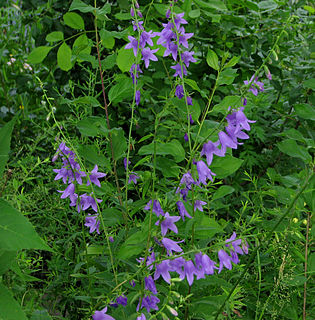
Campanula is one of several genera of flowering plants in the family Campanulaceae commonly known as bellflowers. They take both their common and scientific names from the bell-shaped flowers — campanula is Latin for "little bell".

Campanula rotundifolia, the harebell, Scottish bluebell, or bluebell of Scotland, is a species of flowering plant in the bellflower family Campanulaceae. This herbaceous perennial is found throughout the temperate regions of the northern hemisphere. In Scotland, it is often known simply as bluebell. It is the floral emblem of Sweden where it is known as small bluebell. It produces its violet-blue, bell-shaped flowers in late summer and autumn.

Campanula carpatica, the tussock bellflower or Carpathian harebell, is a species of flowering plant in the family Campanulaceae.

Arctostaphylos auriculata is an endangered species of Arctostaphylos endemic to California, and limited in geography to the area surrounding Mount Diablo, in Contra Costa County.
Helen Katherine Myers Sharsmith was an American biologist.

Campanula rapunculoides, known by the common names creeping bellflower, or rampion bellflower, is a perennial herbaceous plant of the genus Campanula, belonging to the family Campanulaceae. In some parts of North America, it is an extremely invasive species.

Calochortus pulchellus is a rare species of flowering plant in the lily family known by the common name Mt. Diablo fairy-lantern or Mount Diablo globelily.
Campanula angustiflora is a species of flowering plant in the bellflower family Campanulaceae. It is known by the common name Eastwood's bellflower. It is endemic to California, where it grows in the serpentine soils of the hills and mountains surrounding the San Francisco Bay Area. It is a flower of the chaparral plant community. This is a hairy annual herb producing a thin, branching stem up to 20 centimeters tall. The leaves are leathery in texture and oval in shape, measuring between 0.5 and 1 centimeter in length, with a few teeth along the edges. The bell-shaped flower is pale blue or white and just a few millimeters long. The fruit is a ribbed, spherical capsule.
Campanula californica is a species of flowering plant in the bellflower family Campanulaceae, known by the common names swamp bellflower and swamp harebell. It is endemic to California, where it grows along the coastline between Marin and Mendocino Counties. It is found mainly in wet areas such as bogs, marshes, and wet forest floors. This is a hairy rhizomatous perennial herb producing a thin, creeping stem 10 to 30 centimeters long. The thin, rippled leaves are oval in shape and between 1 and 2 centimeters long. The bell-shaped flower is pale blue with curving petals up to 1.5 centimeters long. The fruit is a ribbed, spherical capsule.

Campanula griffinii is a species of bellflower known by the common name Griffin's bellflower. It is endemic to California, where it grows in the North and Central Coast Ranges in chaparral habitat on serpentine soils. This is an annual herb producing a thin, erect stem up to 20 centimeters tall. The leathery leaves are linear in shape, toothed along the edges, and less than a centimeter long. The stem and foliage are sometimes reddish in color and may have stiff hairs. The small, cylindrical flower is pale blue to white and less than 4 millimeters long. The fruit is an oblong, ribbed capsule.

Campanula scouleri is a species of bellflower known by the common names pale bellflower and Scouler's harebell. It is native to the mountains of western North America from northern California to Alaska.

Campanula sharsmithiae is a rare species of bellflower known by the common names Mt. Hamilton bellflower and Sharsmith's harebell. It is endemic to California, where it is known from just a few occurrences in the higher mountain peaks just south of the San Francisco Bay Area, including Mt. Hamilton and Mount Boardman in the Diablo Range. It is a small, hairy annual herb producing an erect stem up to 25 centimeters tall. The fleshy, toothed leaves are a centimeter long or less. The flower is funnel- or bell-shaped and purple in color. The plant is named for late local botanist Helen Sharsmith.

Campanula wilkinsiana is a rare species of bellflower known by the common name Wilkins' bellflower.
C. californica may refer to:

Favratia zoysii, known commonly as Zois' bellflower, Zoysi's harebell, or crimped bellflower, is the sole member of the genus Favratia, closely related to Campanula (bellflowers).

Campanula piperi is a species of flowering plant in the bellflower family, Campanulaceae. It is native to the Olympic Mountains on the Olympic Peninsula in the U.S. state of Washington. It has also been noted on Vancouver Island, British Columbia.

Campanula raineri is a species of flowering plant in the genus Campanula of the family Campanulaceae, native to the Swiss and Italian Alps. It is a low-growing herbaceous perennial growing 5–8 cm (2–3 in) tall by up to 20 cm (8 in) wide, with pale lilac bell-shaped flowers in summer. It is suitable for cultivation in the alpinum or rock garden. It spreads by underground runners. Its locus classicus is located in Canzo, Lombardy.

Campanula lasiocarpa, also known as the mountain harebell or Alaska harebell, is a plant native to the northwestern portion of North America including the US states of Alaska and Washington, as well as the Canadian provinces of Alberta, British Columbia, the Northwest Territories, and the Yukon.















